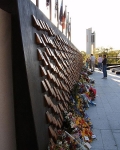National Police Memorial Australia
Archaeology »
Archaeological Monuments » National Police Memorial Australia
National Police Memorial Australia - Australia
National Police Memorial Australia is located in Canberra.
National Police Memorial Australia monument was established on 2005.
Primary threats to National Police Memorial Australia :
A bronze commemorative wall with 'touchstone plaques' carrying the name and rank, date of death (day, month and year), and place of death, of police officers who have died whilst on active duty; a large stone paved area or 'terrain' across which visitors move to gain access to the wall.
Historical facts of National Police Memorial Australia :
- The National Police Memorial in Australia is a significant tribute to the country's police officers who have lost their lives in the line of duty. This essay will explore the historical facts surrounding the establishment and importance of the National Police Memorial.
- The idea of creating a national memorial to honor fallen police officers originated from a deep appreciation for the sacrifices made by those who serve and protect the community. The Australian Federal Police Association (AFPA) played a crucial role in championing the cause and garnering support from various stakeholders, including government agencies, police associations, and the public.
- After years of dedicated efforts, the National Police Memorial was officially opened on September 29, 2006, in the nation's capital, Canberra. The memorial was strategically located on the shores of Lake Burley Griffin, adjacent to the iconic National Carillon and within close proximity to the Australian War Memorial.
- The design of the memorial was the result of a national competition that invited architects and designers to submit their proposals. The winning design, created by a collaborative team of architects and artists, was chosen for its ability to convey a sense of reverence and remembrance. The memorial consists of several key elements, each with its symbolic significance.
- At the heart of the memorial stands the "Eternal Flame," a powerful symbol of everlasting gratitude and remembrance. It is an eternal flame that burns continuously, representing the enduring spirit and commitment of the fallen officers.
- Surrounding the Eternal Flame is a reflective wall known as the "Wall of Remembrance." This wall features the names of police officers who have lost their lives in the line of duty. The names are meticulously engraved, ensuring that each officer's sacrifice is permanently memorialized.
- Adjacent to the Wall of Remembrance is a water feature known as the "Memorial Pool." The tranquil pool reflects the names on the wall, creating a sense of serenity and solemnity. Visitors can pause and reflect on the sacrifices made by these brave men and women.
- The National Police Memorial serves as a place of commemoration and reflection, providing an opportunity for families, friends, and colleagues to pay their respects and honor the fallen officers. It also serves as a gathering place for memorial services, remembrance ceremonies, and other events that commemorate the contributions of police officers across the country.
- The memorial holds deep significance for the Australian community, as it serves as a powerful reminder of the risks and challenges faced by police officers in their daily work. It underscores the importance of their role in maintaining law and order and protecting the safety and well-being of citizens.
- Since its establishment, the National Police Memorial has become an integral part of Australia's national landscape. It has gained recognition as a place of national significance, drawing visitors from across the country and around the world. The memorial stands as a testament to the collective appreciation and gratitude for the dedication and sacrifice of Australia's police officers.
- In conclusion, the National Police Memorial in Australia is a solemn and significant tribute to the police officers who have lost their lives in service to their communities. Its establishment was driven by a deep respect for their sacrifice and a desire to honor their memory. Through its design and symbolism, the memorial serves as a place of remembrance and reflection, reminding us of the bravery and selflessness of these officers.

